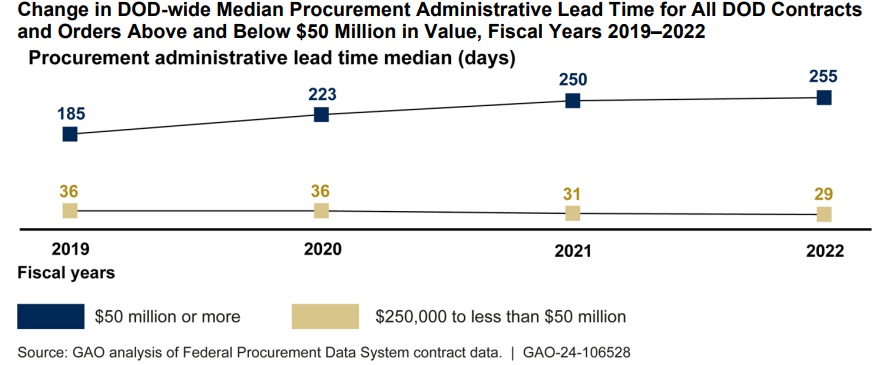DoD award lead times increased for higher value contracts
The military services have been able to reduce contract award times, but DoD lacks department-wide understanding of changes.
While the award lead times have generally decreased for defense contracts and orders over $250,000 in the last several years, it takes longer for the Defense Department to award larger contracts.
The Defense Department uses the metric known as procurement administrative lead time, or PALT, to measure the time between the date an initial solicitation for a contract goes out and the date a contract is awarded.
A government watchdog agency said that while there have been improvements in contracting processes since DoD began collecting data to measure PALT in 2018, the award lead times vary depending on total contract value, contracting approach, contract type, extent of competition and the type of product or service procured.
For example, the award time on orders valued over $50 million increased by 70 days in the last four years.

The Government Accountability Office found that the median DoD-wide award lead times decreased by more than 20%, from 41 days in 2019 to 32 days in 2022.
DoD-wide median lead time by contracting approach:
- Definitive contracts: 97 days
- Indefinite delivery contracts: 179 days
- Orders: 21 days
Median order award times are generally shorter across the service branches, while definitive and indefinite delivery contracts take significantly longer to award. For example, the Navy takes 132 days to award a definitive contract and 185 days to award indefinite delivery contracts.
In some instances, it takes under a day to place an order since those can be fulfilled through an indefinite delivery contract awarded to one vendor where all terms and conditions are already established.
For example, the Defense Logistics agency awards many orders for commercial goods, services and supply items on existing indefinite delivery contracts, often with the help of automation, which allows the agency to process the awards in under one day.
“Over 85% of all definitive contracts awarded and over 90% of all orders issued by DoD from fiscal years 2019 through 2022 were below $10 million in value and had shorter median PALT timeframes. PALT values, both DoD-wide and within selected components, were generally longer for the award of definitive contracts and orders with larger total contract values,” the report stated.
The Army and Navy contracting processes decreased by 13% and 12%, respectively, while the median award times remained the same for the Air Force and the Defense Logistics Agency.
Additionally, the award times decreased for competed contracts but remained the same for sole-source contracts or those awarded through other non-competitive methods.

For example, the Army takes 247 days to award a contract within the research and development category, but it takes 102 days for the Navy and 131 days for the Air Force to award a contract within the research and development category.
For comparison, the Army takes 69 days to award a contract within the electronic and communication equipment category, while it takes 55 days for the Navy and 42 days for the Air Force to award a contract within the same category.
Generally, the service branches have adopted strategies to monitor award times.
The Naval Sea Systems Command categorizes its contract awards by competed and non-competed contracts and then sets its goals.
For example, the command’s goal for sole source procurements is not to exceed 210 days, while competitive procurements cannot to exceed 240 days.
The Army categorizes contract awards into four groups and assigns award-time estimate to each group by dollar value and contracting approach.
For example, for $100 million to $250 million contracts, the award times range from 80 days for orders placed on an existing indefinite delivery contract awarded to one vendor to 270 days for awards of new contracts.
But DoD doesn’t have department-wide visibility and understanding of the award times. And the DoD’s PALT tracker has shown to be of limited use because of its incomplete data.
Additionally, the military services don’t find the PALT tracker useful and “reported that it is burdensome and duplicative of other systems they use.”
“Given these different perspectives, DoD would benefit from engaging with the components to determine if the PALT Tracker is needed to enhance DoD’s visibility into PALT changes for higher-dollar value contracts,” the report stated.
Copyright © 2024 Federal News Network. All rights reserved. This website is not intended for users located within the European Economic Area.






